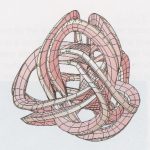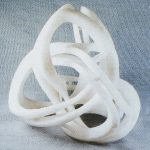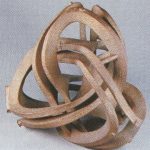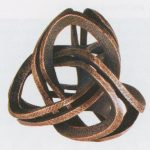Bathsheba Grossman: Flow Bronze
Artist(s):
Title:
- Flow Bronze
Exhibition:
Creation Year:
- 2002
Medium:
- bronze cast from CAD/CAM prototype
Size:
- 9 x 6 x 6 inches
Category:
Keywords:
Artist Statement:
I’m a digital sculptor, using metal and glass to create abstract geometries in space. This work explores order in space: tensions between inside and outside, the point at zero and the point at infinite distance, how the dimensional axes can be alike and different. I got interested in these things as an undergraduate in mathematics, wanting to cross over from formal abstractions into working with physical shapes, and sculpture gave me the way.
I’m often asked whether these pieces are based on logic or intuition. If this is a multiple-choice question, it’s not an easy one: let’s say that my intuition operates with mathematics at the back of its mind. The process is pure analog. I push things with my hands until they look good to my eyes, but the results show that my creative engine is inextricably fused with geometrical intuition. My work is to explore and extend the fertile region between sculpture and mathematics.
Technical Information:
My designs exist first as CAD models, and they enter the physical world as wax or plastic parts built by rapid-prototyping technology. Then they’re translated into metal by the ancient and effective lost-wax method, and I finish the bronzes using hand tools that Praxiteles would recognize. So the process moves, as it were, backward in time: from virtual idea to hand-finished metal.
The sculptures are made in limited editions, but without mold-making; each instance of a piece is cast directly from a new prototyped model. It’s impossible to make molds of my work. It is too involuted for even flexible tooling to work, so without prototyping there could be no editions at all.
Prototyping technology is a young, crude business as I write this, but it’s the germ of an artistic sea change. It brings sculpture into the company of poetry and music, among the eternal media. Because the originals of my work are now data, they transcend location, medium, and time. Ultimately, in my lifetime I hope, art sculpture will be manufactured on demand, at the size, medium, and price point requested by the viewer. Far from threatening the value of sculptures by eroding their scarcity, I believe that this will allow them to reach their natural audience, so that they can be owned by everyone who likes them. We are standing at the Gutenberg moment for sculpture: it will soon be affordable, ubiquitous, and-like everything else that shares those properties-digital.
Process Information:
I begin by contemplating a shape: maybe a familiar solid such as the cube, or a more esoteric one like the snub cube or rhombic dodecahedron. I think about it with some modeling clay in hand, and perhaps some possibilities develop; eventually something emerges that might be interesting to build. Sometimes it isn’t easy to visualize, but usually I can at least indicate my idea in the plasticene well enough to remember it.
Next I need a CAD design. I make this by re-modeling the piece, rather than attempting to digitize it, as no scanner can pick up all the involutions of these forms. Here I fine-tune the design, making precise what was rough in the clay, nailing down proportions and details. This is the longest and hardest part: many, many days can go into the model, and when I finally see it printed, as often as not it goes back to the drawing board.
When I have the model complete in the computer, I print it on my 30 printer, or if the piece is to be large, send it to a service bureau. In either case, a physical model is fabricated from my CAD design by building it up in layers, one layer at a time. This additive method allows very free geometry; it’s not nearly so limiting as CNC methods, in which the piece is carved. During the build, support for undercuts is provided in various ingenious ways. The machine I have, a Solidscape Modelmaker II, builds support structures in a different material from the actual part, and the supports are dissolved away in a solvent bath after the build is done.
The result of the prototyping process is a strongly grained model, showing the layers it was made with, that can look a little like rough wood. The material is plastic or wax, and it may be more or less durable, but in no case is it pretty. The next step is to cast it into a material that is both aesthetic and archival: metal.
This is done by the lost-wax method, an ancient and flexible casting process that can handle almost any geometry. The disadvantage to this method is it destroys the original model (hence “lost-wax”), so a new wax is required for each casting. For most sculptors, multiple-waxes models can come from a mold, but since that isn’t possible for my designs, I build a new prototype for each piece.
I finish the rough castings with hand and power tools: files, grinders, polishers, an occasional weld. The piece·is darkened with a hot chemical patina. In some areas, the texture is left intact for a rich surface. In others, I abrade it lightly, and for highlights, it’s polished away entirely. Finally the piece is lacquered to protect the finish, and it’s done: my geometrical intuition has been realized in the physical world.
Online gallery for bronzes: bathsheba.com
Silver sculpture and jewelry: microsculpture.com
Prototyping service bureau that specializes in small-scale creative projects: protoshape.com
Other Information:
Images:
1-4: Alter Knot









